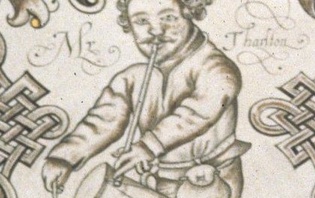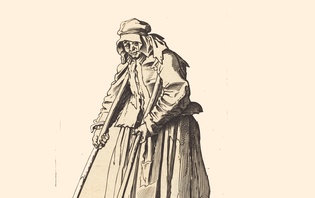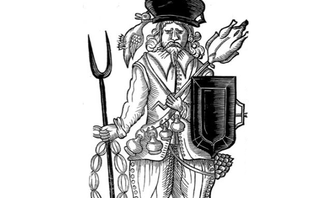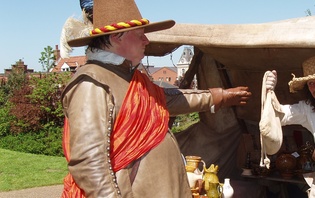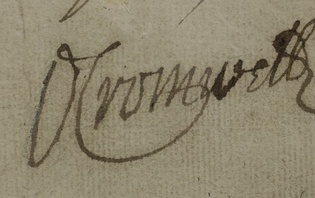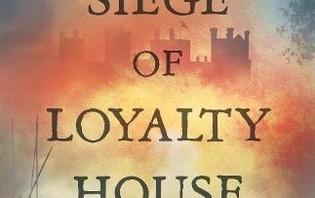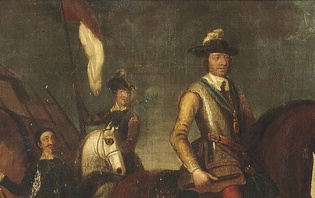Straight from the Horse-Owner’s Mouth: George Rolph and the Fate of Civil War Wagoners
Maimed soldiers and soldiers’ widows were not the only people whose lives were ruined by the civil wars. Many more people suffered material losses or had their worlds turned upside down. They too petitioned for redress for a wide range of calamities. Unfortunately, due to time restraints, Civil War petitions will not be able to include these additional cases within the main project but we hope to draw attention to them via the blog. Here, in our first guest blog, Dr Gavin Robinson, examines the fate of horses and their owners impressed into Civil War armies.
George Rolph or Rolfe was a wagoner from Latton in Essex (this could be Latton, now in Harlow, or Leyton, now in London). He petitioned the Essex Quarter Sessions in January 1658 that ‘his Waggon & horses were some yeares since impressed for the carryeing Ammuicon from London towards the releife of Glocester then besieged, and soe continued in the Parliments service until the Wagon was broken & horses killed at Newbury fight, for which the Peticoner had noe satisfacon and whereby hee is brought into Poverty’. He was granted a one-off payment of £10, but petitioned again in October. He was then given another £10, ‘Provided he never after trouble the Court wth any further Complaint therein, as hee now promiseth’. The relief of Gloucester and first battle of Newbury happened in September 1643, so Rolfe had waited 15 years for compensation. He may have tried and failed to get money from other sources, but no records of that have turned up.
£20 is a large sum, but it was not necessarily generous considering the scale of Rolfe’s losses. Civil War armies paid up to £6 for draught horses, and there could often be five or six horses in a team. The Eastern Association paid £7.10s for an ammunition wagon in 1644. The capital needed to set up in businesses means that wagoners were probably middling entrepreneurs, but Rolfe’s case shows that they could easily be ruined if they lost their horses.
During the Civil Wars, the risk of losing horses increased because armies needed so many of them. The planned establishment for the New Model Army’s artillery train included 32 artillery pieces, 132 wagons and carts, and over 1,000 draught horses (TNA, SP 28/145, ff. 60-64). The earl of Essex’s train had been a similar size. In May 1644, its accounts (TNA, SP 28/146, f. 183) show that it had:
- 613 state-owned horses
- 179 horses hired from contractors
- 50 teams of horses temporarily impressed
Essex’s artillery never had enough state horses, so they relied on hiring and impressment to make up the deficit. For armies, the main advantage of impressment was that it was cheap, but it was not always efficient. A shortage of horses could help to explain why Essex’s artillery train was notoriously slow before the battle of Edgehill. Letters from royalist commanders sometimes mention that they could not get enough horses to move their artillery or ammunition. Whenever royalist commissaries took up large numbers of horses and wagons, it gave parliamentarian scouts a clue that the enemy army was about to move. To avoid these problems, the New Model Army was intended to have enough draught horses of its own but impressment was still needed sometimes. Sir Thomas Fairfax impressed teams of horses from Old Milverton, Warwickshire, in June 1645 to carry ammunition (TNA, SP 28/183). Humphrey Lower, keeper of the Army’s stores at Reading, paid for sending warrants to local constables to impress carts. Although the carters were paid sixpence per mile, they were not willing volunteers. Lower also had to pay, ‘to Guard the 3 Gates at Redding to keepe these Carts that they might not goe thence, as some of them indeavoured’ (TNA, SP 28/202, f. 234r).
Impressment was an even bigger problem for civilians than for armies. George Rolfe’s case is not very unusual. Although impressment was usually temporary, the risk of horses being killed or captured by the enemy was much higher when serving with an army. Even if the horses returned safely, their owners still suffered inconvenience and loss of earnings. Parish accounts of losses are full of claims for cart service and losses of horses. Buckinghamshire suffered very badly because it was where the relief force for Gloucester gathered before setting off in late August 1643. We don’t know where George Rolfe’s horses were impressed. Wagoners had to travel to carry out their business. Robert Bennett, a wagoner from Exeter, took a load of cloth from Devon to London, where he, his wagon, and seven horses were impressed into the earl of Essex’s artillery train in September 1642. They served until 23 October, when the wagon and horses were lost at the battle of Edgehill. Bennett’s petition to the earl of Essex resulted in £82 compensation. It’s not clear why George Rolfe didn’t get his money this way.
Once horses were impressed into an army, there were many things that could go wrong. George Rolfe’s horses were killed in a battle, but accidents could happen even when there were no enemies around. Henry Foster’s narrative of the relief of Gloucester says that when the column was at the top of Prestbury Hill, near Cheltenham, on the evening of 5 September 1643:
‘it began to be very darke, so that our waggons and carriages could not get downe the hill, many of them were overthrowne and broken, it being a very craggy steep and dangerous hill, so that the rest of the waggons durst not adventure to goe downe, but stayed all night there: sixe or seven horses lay dead there the next morning, that were killed by the overthrow of the waggons’
In 1644, Essex’s army took horses from Buckinghamshire all the way to Cornwall, where they were lost. The surviving parish accounts for Buckinghamshire, which cover just over a third of the county, claim that during the First Civil War, 81 impressed draught horses never came back.
Impressment put the wagoners themselves at risk, because someone had to drive the wagon and look after the horses. They suffered badly when Prince Rupert’s cavalry attacked the parliamentarian baggage at the battle of Edgehill. John Padgitt claimed to have suffered two wounds as well as losing a wagon, three horses and harness worth £23. Thomas Padgitt was also wounded and his son was killed, on top of £27 of losses in horses and harness. Together with John Wilde, they petitioned the Committee of Safety and were paid £75.10s between them (TNA, SP 28/6/2, f. 255; SP 28/263, ff. 23-24). Will the project find any more petitions from maimed wagoners?
Dr Gavin Robinson is an independent researcher. He has published articles and a book on horses in the English Civil War. He also runs his own business, doing manuscript transcription and data cleaning for historians.

